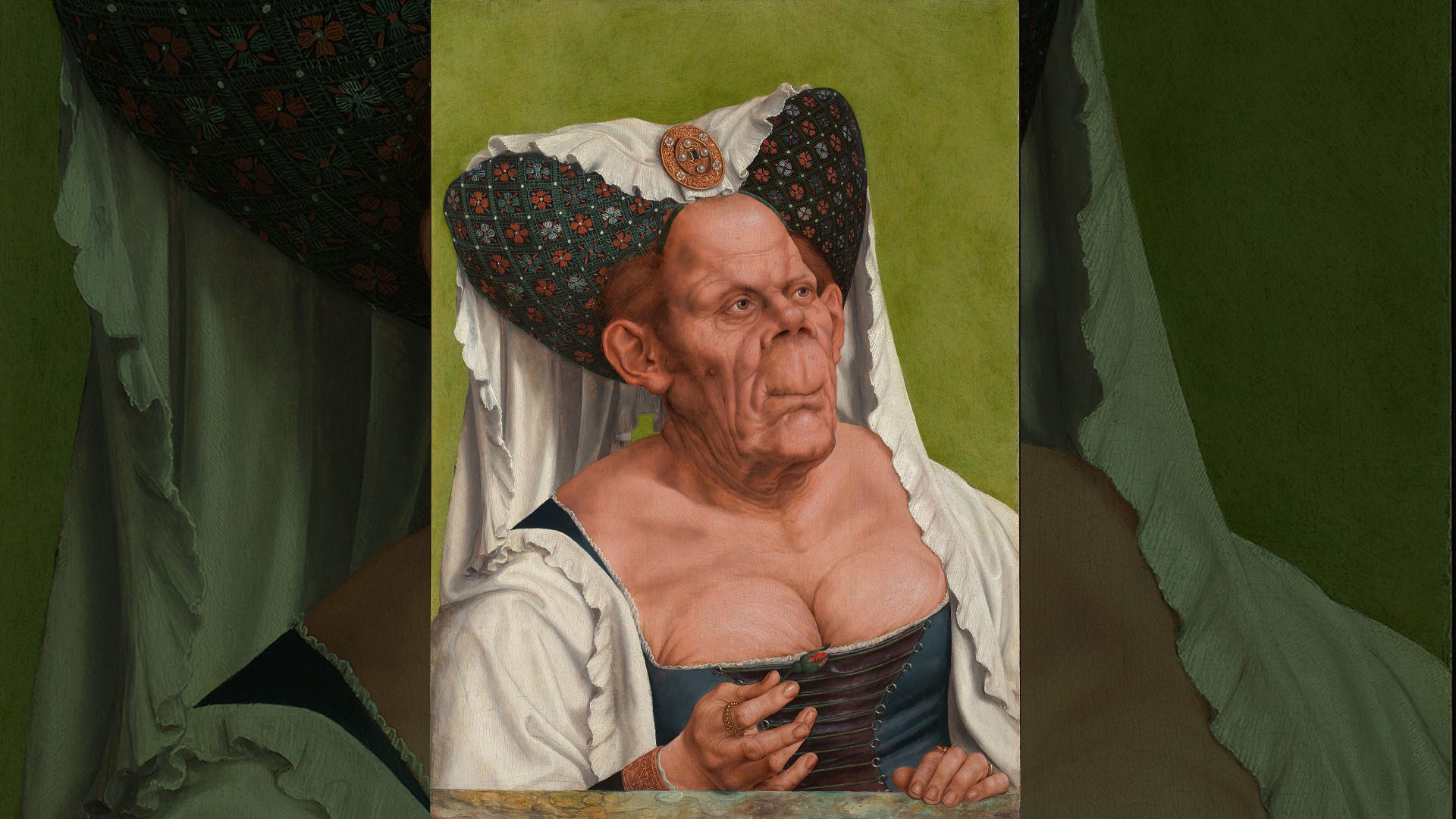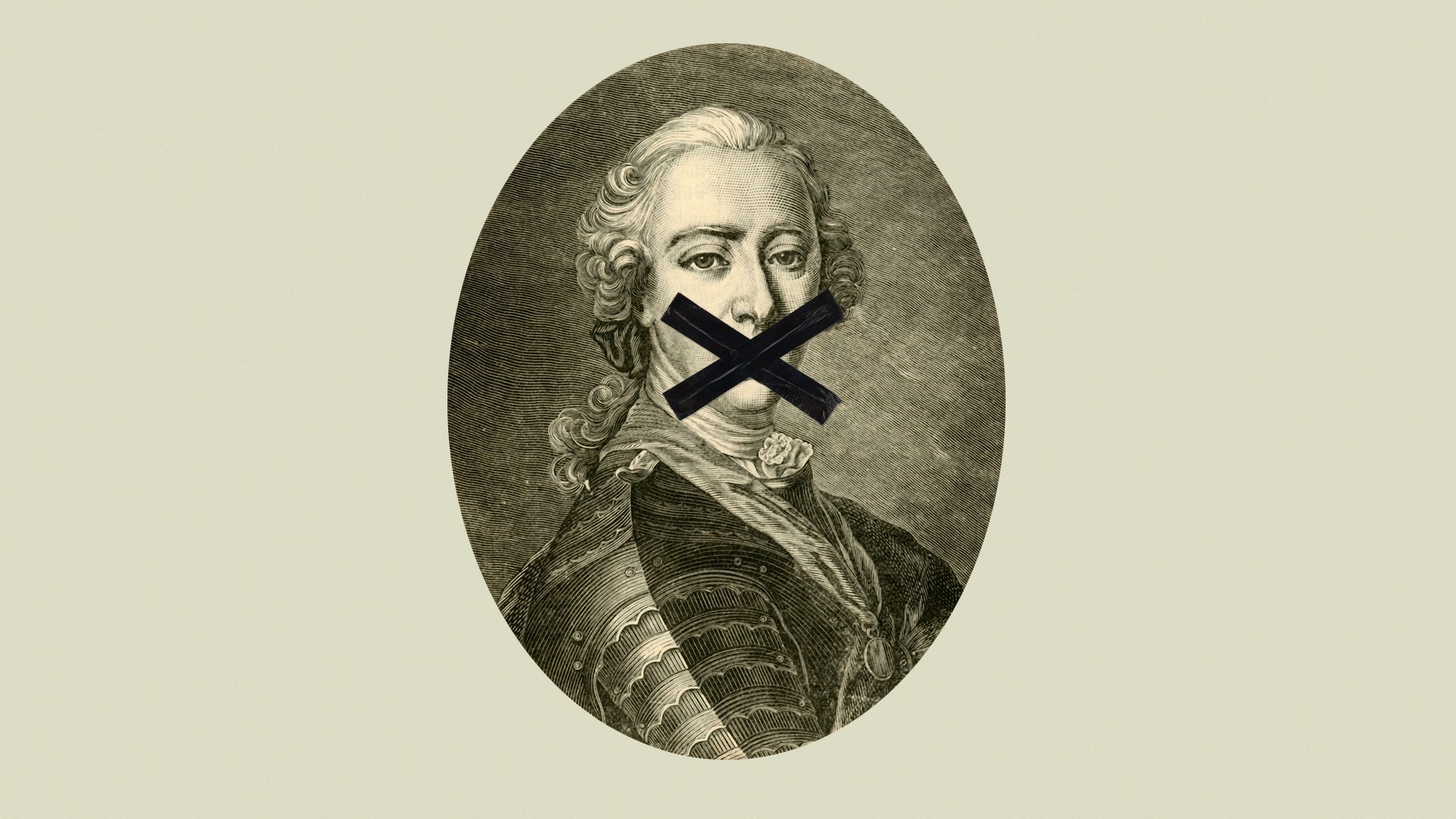She invites our ridicule, our superiority. Her facial deformities – an exaggerated forehead, short snub nose and toothless, closed mouth – vie with her sagging, wrinkled breasts which her tight, low-cut dress has pushed up. She holds a limp rosebud in her hand, perhaps proffering it as a love token.
An Old Woman, painted around 1513 by the Flemish artist Quinten Massys (1465/6-1530) currently forms the centrepiece of a National Gallery exhibition that examines “beauty and satire in the Renaissance.” But is the intent purely to satirise, or does the work show something else entirely about its subject – and indeed its painter?
The work is better known today as The Ugly Duchess after the illustrator John Tenniel appropriated it to depict the hideous duchess in his much-loved drawings for Lewis Carroll’s Alice’s Adventures in Wonderland (1865). Massys, however, did some appropriating of his own; An Old Woman interprets a now-lost drawing by Leonardo da Vinci which survives in the form of a copy by his pupil and heir Francesco Melzi, The bust of a grotesque old woman (1510-20). While Melzi’s da Vinci copy portrays the woman with expressive, wistful eyes, Massys sees a lustful seductress with a piercing stare.
Who could she be staring at? The answer comes in Massys’ companion work An Old Man, also made around 1513. Again it is probably inspired by what da Vinci called his visi mostruosi (monstrous faces) sketches – though some have suggested that since the two artists corresponded, Massys may even have sent his early sketches to Italy for da Vinci or a follower to copy. The man is not quite as ugly as the duchess but they are clearly intended as a pairing, visible in the continuous marble parapet and identical positioning of their left hands.
Are the old man and woman real people or simply Netherlandish “tronies”? These were works popular in the 16th and 17th centuries, typically depicting characters with exaggerated facial expressions or strong facial characteristics. Popularised by the likes of Frans Floris and Jan Lievens, tronies were not commissioned portraits and therefore their artists could depict the humble models who inspired Franz Haals’ Gypsy Girl and Johannes Vermeer’s Girl with a Pearl Earring.
Yet neither were tronies intended to be caricatures, and this has led some to speculate whether An Old Woman is actually a female with a rare illness called Paget’s disease, a metabolic abnormality that enlarges and deforms the bones. In this theory, an advanced form of the disease, named after a British surgeon, has spread to her head, distorting her jaw, extending her upper lip and pushing up her nose.
Or could it be that duchess looks that way because “she” is not really a “she” at all? Emma Capron, who has written the exhibition’s companion book, believes the figure may even be a cross-dressing man, perhaps spotted by Massys during one of his frequent visits to local carnivals.
Whoever it depicts, The Ugly Duchess seems like a gateway from the 16th century to 20th-century political satire, perhaps most cruelly in the manly, manic caricature of former prime minister Margaret Thatcher. Massys was certainly a pioneer in the field of enlarging a person’s most noticeable or least attractive characteristics in grotesque form; moneylenders and mismatched couples as visual moral lessons. But his work had not always been that way. At the time An Old Woman was created, Massys (also known as Metsys and Matsys) was recognised as a master painter, noted primarily for religious paintings but moving more towards portraiture.
He was born in the university town of Leuven and apprenticed as a metalsmith, possibly in his father’s forge but turned to an apprenticeship in painting. He is documented in Antwerp from 1491 as a member of St Luke’s Guild, living and working as a master craftsman. He married into wealth twice and lived a prosperous life. Two sons from his second marriage, Cornelis and Jan, became painters too.
The city was an immensely prosperous centre for the mercantile industry, and the publishing and book trade. It was a hub for art. In the 16th century, Antwerp was recorded to have more painters and sculptors than bakers in the city, and a progressive circle of humanists.
Massys’ reputation brought special visitors to his house, including Albrecht Dürer, who stayed temporarily in Antwerp from 1520-21, and Hans Holbein the Younger, who stopped in the city on his way to London in August 1526 in order to deliver a letter from the Dutch theologian and philosopher Desiderius Erasmus to a friend, Pieter Gillis, a philosopher and magistrate. The letter was a request to introduce Holbein to Massys, possibly to discuss the technique of pendant portraiture – paintings intended as a pair – following Massys’ remarkable 1517 pendants of Erasmus and Gillis, painted as gifts to Sir Thomas More.
This humanist circle of philosophers became patrons of Massys, and they also root the grotesque depictions of An Old Woman and An Old Man in satire through their literary writings. One can go back to Ovid’s Metamorphoses in around 8AD to find misogynistic disdain for women but in the context of 15th- and early 16th-century northern Europe, The Ship of Fools (Das Narrenschiff) 1494 by the German humanist Sebastian Brant (1457/8-1521) introduced the satirical appraisal of foolish, vain and greedy people with few morals. Erasmus’ 1509 essay In Praise of Folly and later More’s Utopia (1516) explore this association, which opens connections to Massys’s odd couple.
The old man and old woman in Massys’s depictions wear outdated clothes. The horned headdress of the woman was a style of the 1460s. Clothing and appearance were used as visual tools in art to accentuate or deride status, and images of old women were manipulated as derogatory symbols of lust and envy and other “deadly sins”. Erasmus’s In Praise of Folly harshly satirised older women who plucked their facial hair, wore make-up, and dressed improperly to attract men. The grotesque had a different meaning in this era, a visual education in morality through satire and jocularity. Yet the treatment of the duchess has made some viewers of this current exhibition uncomfortable. “I’m not sure how funny this satire is,” ceramicist Lindsey Mendick told the Evening Standard. While admitting she loved the painting – “it’s impossible not to” – she added, “there’s something deeply unsettling about men making work about older women when women have never had the same place in a gallery setting. To me, it does not seem satirical. To me, it seems cruel.”
The character in An Old Man certainly fares better than his counterpart. His clothing may not be the height of fashion but he is dressed with an air of prosperity. He is depicted in profile looking towards the “duchess” and raising his right hand. It looks both a greeting and a rejection. Is he resisting her advances?
The detail of the gold ring worn on the man’s right thumb is relevant here, it was worn as a mark of distinction by important people but connotes greed and power. Erasmus’s essay focuses on the attire of vain men, easily recognised by their gold rings worn on the thumb, to show wealth and power. His texts could be describing Massys’s odd couple and the painter may have used Erasmus’s essay to encourage a commission.
Portrayals of mismatched couples became a comment on Renaissance society. There are many drawings, engravings and paintings of young women with ugly older men or vice-versa, and gentle digs at ageing lovers. Brant and Erasmus made fun of them.
And not all couples were depicted as louche or greedy individuals. The National Gallery’s remarkable painting An Elderly Couple, c.1520, by French-born Netherlandish painter Jan Gossaert (c.1478-1532) focuses on two prosperous older people, depicted together but seemingly detached and despondent. They look past each other into the distance. He wears a badge on his hat with a classical emblem of two lovers standing naked in front of a tree, perhaps a guild membership or Gossaert’s inference to more interesting times in the couple’s earlier life.
Of course, An Elderly Couple does not have an exhibition named after it, while The Ugly Duchess does. Whoever its inspiration was and whatever the motivation for its creation, Massys’s work remains one of the National Gallery’s most popular portraits, partly because vanity and greed are timeless traits.
The most visible people in our society distort themselves; at the 2023 Academy Awards, nominees who received the Oscars “goodie bag” got vouchers for a $7,000 hair restoration consultation; $12,000 of arm liposuction, and up to $10,000 of facial procedures, including laser resurfacing, chemical peels and Botox. The Ugly Duchess would almost certainly been interested. “Curiouser and curiouser,” as Alice would say.
The Ugly Duchess: Beauty and Satire in the Renaissance at the National Gallery ends on June 11



